 |
GREECE & ROME |
 |
|---|

[500-BC - 350-AD]
FORWARD:
As stated elsewhere, the purpose of this historical section is not simply to repeat hear-say or what other websites are saying but to actually provide the reader with actual first hand historical sources as they relate to the use of Medical Cannabis. Unfortunately, due to a variety of factors, this is NOT always possible.
To begin with, while both the Greeks and Romans were literate people, noted for writing numerous works. Still due to what now has become known as the dark ages, few of these works have come down to us today. At least NOT in their original condition; the chart below shows the general pattern of language translations:
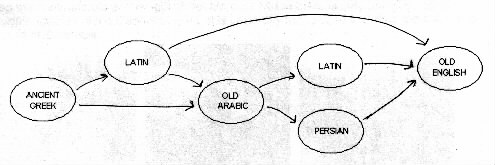
As one can see, the original works (those that survived at all) have seen numerous translations from their original language. And that’s if we're lucky, many works have never actually be translated into modern-day English assuming they survived at all. Which therefore forces us to rely on hear-say, or basically on what someone (who may or may not be able to read the original language), claims was once said. Ugh!
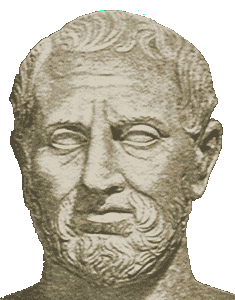
THEOPHRASTUS (287 - 371 B.C.), provides a good example of this problem. According to the Parke-Davis History of Pharmacy (series) [1], “. . . He was a noted Greek naturalist who today is regarded as the 'father of botany,' whose writings are (for the most part) still accurate today.”
All fine and well, but what did he write down about Medical Cannabis? Answer: We don’t know. Almost all information that we’ve been able to locate, failed to make any mention on the subject. And while some (pro-Medical Cannabis) websites claim that he did, none seem to be able to provide any actual proof; no direct quotations etc.
But even without proof, this museum believes that he most assuredly had to have made references to and use of Cannabis. It would have been all but impossible for him not to have.
HOWEVER, all this brings up the obvious question -- Why didn’t such a valuable medical agent receive more notice and attention from the ancient Greeks or Romans? As will be shown, they wrote much about the medical properties of the Hemp Seeds, but virtually nothing about the much more (medically) useful flowering tops. Why?
There are those who point out that (even back then) there was much travel between Roman, Greece, Egypt, Mesopotamia etc. Therefore, by implication, that there was no excuse to NOT HAVE KNOWN. As Barbara Griggs stated in her book “The Green Pharmacy:
". . The drug inventories of the three great civilizations of Mesopotamia, Egypt and India show such remarkable similarities that there was obviously a continual exchange of discovery and information among the professionals”But maybe we shouldn’t be to fast to judge the ancients. While wishing to side step the centuries old and on-going debate over where there is only one species, or multiple species of the Cannabis plant. It is generally recognized that there are three sub-groups of Cannabis:
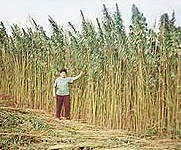 Cannabis Sativa* |
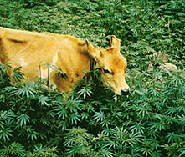 Cannabis Ruderalls* |
Cannabis Indica* |
- Cannabis Sativa, (Europe) which can grow to a height of over 18 Feet. Useful for rope, canvas, cloth etc. Unfortunately, it seems to have only a fraction of the active medical ingredients found in Cannabis Indica.
- Cannabis Ruderalis (Central Asia, Siberia) which only grows to a height of 3 feet (if you're lucky). -- While its small flower tops do have some of the medically active ingredient, in general it is considered cattle fodder.
- Cannabis Indica (India, China etc.) which grows to a height of about 4 feet. Lots of medical uses.
* Pictures taken from off the Internet, we were unable to make contact with picture takers
THE EARLIEST KNOWN MEDICAL TRADEMARK: [500-BC]

Although having nothing to do with Medical Cannabis, as this museum deals mostly with Cannabis antiques having brand or trade names. The reader may be interested in knowing that it was the Greeks (500 BC) that invented the concept. Before that all medicines were generic in nature. According to the Parke-Davis Co. (History of Pharmacy Series):
“One of the first therapeutic agents to bear such a mark was Terra Sigillata (Sealed Earth), a clay tablet originating on the Mediterranean island of Lemnos before 500 B.C. One day each year clay was dug from a pit on a Lemnian hillside in the presence of governmental and religious dignitaries. Washed, refined, rolled to a mass of proper thickness, the clay was formed into pastilles and impressed with an official seal by priestesses, then sun-dried. The tablets were then widely distributed commercially.”Dioscorides was supposed to have recommended Lemnos clay as a treatment for wounds and ulcers. [Note, the clay is known to have some kind of microbes which actually do help.]
HERODOTUS [The Greek Historian] 490 - 425-BC
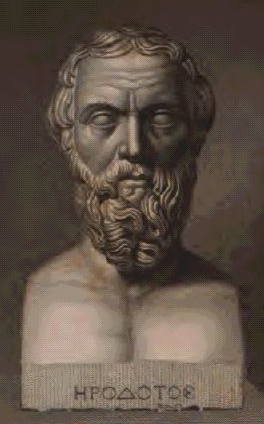
HERODOTUS The Historian
To our knowledge, Herodotus (the Greek Historian) was the first to make any mention of Cannabis in Western literature. He's said to have been born at Halicarnaffus (490 AD), and traveled throughout much of Greece, Egypt, Babylon, Tyre, Thrace, Scythia, Arabia, Palestine etc. [See Map] And while he probably knew little about medicines, (thus wrote little about the subject), still his are one of the few historical works from that era that have come down to us today.
But unfortunately he is also one of the most widely misquoted of Greek historians. With his words being taken out of context, especially during the Reefer Madness Era of the 1930’s. When the narc’s (Americas Narcotics Police) deliberately distorted his writings, with the following quotation targeted for use used, over and over again:
“The Scythians put the Seeds of this HEMP under the bags, upon the burning stones; and immediately a more agreeable vapor is emitted than from the incense burnt in Greece. The Company extremely transported with the scent, howl aloud.“Again, the above statements were used, over and over again; by the narcotics police as proof that Medical Cannabis (a.k.a. Marihuana, the Weed of Madness), ever since antiquity, had the power to turn its users into cold-blooded murderers, etc. However, if one were to read the paragraphs just before and after the above quotation, a totally different picture begins to appear. [See Actual Wording]:
“The HISTORY of HERODOTUS”Looking at the more complete quotation, these are the facts the way this museum sees them:
Translated from the Greek by Isaac Littlebury [1737] [2] “
“[PAGE 380] [description of a funeral] . . . And this is the Manner of the King’s Funeral. But when any other Scythian dies, his nearest Relations carry him about in a Chariot among his Friends; who receive and entertain the whole Company, in their Turn, setting the same things before the dead Man as before the rest. In this Manner all private Men are carried about forty Days, before they are buried: And those who have assisted at these Funerals, purify themselves thus. When they have cleansed and washed their heads, they set up three pieces of timber leaning to each other, and laying a good number of Woolen Bags close together, throw burning Stones in to a hollow space left in the midst of the wood and bags. In this country a sort of HEMP grows, very like to flax; only longer and thicker; and much more excellent than ours, whether sowed or produced by Nature. The Thracians cloth themselves with garments made of the HEMP; so well resembling Flax, that a man must have great experience in those materials to distinguish one from the other: And he who had never seen this HEMP, would think their [PAGE 381] Cloths were wrought out of Flax. The Scythians put the Seeds of this HEMP under the bags, upon the burning stones; and immediately a more agreeable vapor is emitted than from the incense burnt in Greece. The Company extremely transported with the scent, howl aloud; and this Manner of purification serves instead of washing: For they never bath their bodies in water. But their wives grinding the wood of cypress, cedar, and incense upon a rough stone, and infusing the powder in water, compounds a thick substance, which they spread over all the parts of the body and face. . . . . “
- The Hemp Plant in question, given its size and description as a source of clothing, seems to have been an industrial grade (what we would now term Industrial Hemp) plant and thus would have has little Medicinal or recreational uses.
- That the incense vapors were used as part of a religious ceremony for the dead, similarly to the use of the use of myrrh and frankincense by the Roman Catholic Church today. Herodotus even talks about other incenses.
- That Herodotus was writing in the CONTEXT of a funeral. Hey, what do you think the deceases friends are suppose to do at a funeral? In that context Howling, Weeping, Crying all seem normal to me, and in keeping with the situation. Additionally, other translations from the Greek, use the word Yell as oppose to Howl.
- That the Reefer Madness Era conspirators, obviously and deliberately took Herodotus writings, way out of context, in order to distort the facts and thus get their agenda through.
Once more, he made little mention of any medicines, period. Which doesn’t mean that the Scythians did not utilize Cannabis in that way, only that he simply didn’t write anything one way or the other. [MORE - VIEW SELECTED PAGES]

|
GRECO-ROMAN REEFER MADNESS ERA - MYTH INFORMATION |
 |
PLINY (the Elder) 77 AD:

The following is taken from Book 20, of his monstrous works, collectively known as “The Natural History”
[Translated by John Bostock & H.T. Riley MDCCCLVI]Other Books in his Series included:
Book 20: --Drugs obtained from garden plants - Book XX chapter 97. (23.) --- HEMP: Nine Remedies - [Page 297] - Hemp originally grew in the forests, [81] where it is found with a blacker and rougher leaf than in the other [82] kinds. [Page 298] -- Hempseed, [83] it is said, renders men impotent: the juice of this seed will extract worms from the ears, or any insect which may have entered them, though at the cost of producing head-ache. The virtues of hemp, it is said, are so great, that an infusion of it in water will cause it to coagulate: [84] hence it is, that if taken in water, it will arrest looseness in beasts of burden. A decoction of the root in water, relaxes contractions of the joints, and cures gout and similar maladies. It is applied raw to burns, but it must be frequently changed, so as not to let it dry.
FOOTNOTES:
[81] - The wild hemp of Pliny is the Althaea cannabina of Linnaeus: the hemp marsh mallow.
[82] - The cultivated hemp is the Cannabis sativa of Linuaous.
[83] - He is speaking of the hemp marsh-mallow here, and not the real hemp; though at the same time he mingles with his statement several facts which are stated by Dioscorides with reference to the genuine hemp, See B. xix. c. 56.
[84] - This is evidently stated in reference to the hemp-mallow.
And although they make numerous references to Industrial Hemp, for the most part these other sections make little or no mention of additional medical uses. [MORE]
PEDACIUS DIOSCORIEDS - (40 - 90-AD):

Dioscorides, is most noted for his set of Botanical/Medical Books, “De Materia Medica,” which clearly make references to the Medical Cannabis Plant.
Although of Greek origin, he served and traveled with Roman armies throughout the empire, collecting what medical knowledge he could, everywhere he went. In the “De Materia Medica” he documents almost the complete knowledge of Roman Medicine, listing around 600 medical plants and minerals, as well as giving over 900 remedies for various health problems. While much of what he wrote, was (how shall we say it) somewhat incorrect, his works were still in medical use throughout Europe until the mid-16th Century. In later times, his texts (containing numerous illustrations) were translated into numerous languages, including Latin, Arabic, Italian, French, Spanish, English, German, Persian etc.
Dioscorides wrote in Book III of the "Materia Medica”
“Kannabis; is a plant of much use in this life for the twisting of very strong ropes, it has leaves like to the Ash, of a bad scent (insect repellent), long stalks, empty, a round seed, which being eaten of reduces sexual activity, but being juiced when it is green is good for the pains of the ears.”And while it seems that he was only familiar with the medical uses of its seeds, still the fact is that Dioscorides was one of the first Western writers to talk about the plants medical uses.
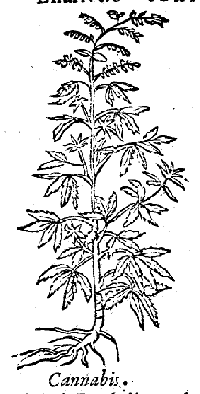
What did Dioscorides Original Drawing Look Like?
Try as we might, this museum has not been able to actually obtain a copy of the original drawing. And thus once more we are reminded that before Gothenburg invented the printing press (1450), ALL books (or copies thereof) were in fact hand-transcribed. However, we do know that it would have been a pretty accurate sketch of the plant. We know that a copy of the Greek Herbal of Dioscorides from the 6th-century Byzantine Empire, contains (what is thought to be) a faithful representation of the Medical Cannabis plant.
CLAUDIUS GALEN - (130-200 A.D.):
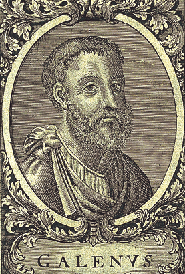
Claudius Galen - (130-200 A.D.)
Although (like Dioscorides) ethnically a Greek, Claudius Galen, is probably the most famous of all the Roman Physicians, whose textbooks (and he wrote very many of them) were still in use throughout Europe during the Middle Ages and well into the 17th Century. In fact Galen’s influence was so great that many historians use him as a sort of historical separator; Before Galen (meaning before Rome), and After Galen (meaning the Middle Ages and after). And at least in this one authors opinion, his writing (translated into Arabic) would form the bases of Arabic medicine during their golden age.
Of special interest to us today are two of his works:
“Hemp seeds are used to create a sort of warmth and/or given to party guests to promote hilarity and enjoyment. Others translations also add; “Hemp cakes, if eaten in moderation, produced a felling of well-being but, taken to excess, they led to intoxication, dehydration and impotence.
It is not the case that since the Indian hemp plant itself resembles the chaste tree, its seed is somehow similar in property to that seed. Rather, it is completely different from it, being difficult to concoct and unwholesome, and produces headaches and unhealthy humours. Nevertheless some people roast and eat it with other sweetmeats. (Clearly, I am calling things that are eaten after dinner for pleasure while drinking, sweetmeats.) The seeds are quite warming, and consequently when they are taken in quantity over a short period they affect the head, sending up to it a vapor that is both warm and like a drug.” --- Book I, Chap. 34[3]

(Kuhn Edition) Book VII, Chapter 10 [5th herb]
TRANSLATION:
“De Simplicium Medica: Temperamentis ac Facultatibus"Note that like Dioscorides, Galen talked only about the medical properties of the Hemp-Seeds and as the reader can tell, not all the information was 100% accurate. However, for better or worse Galen’s reputation as a physician was such that his textbooks would serve as the bases of medicine for well over a thousand years.
“The cannabis’ fruit does not create gas and is so dry that it can dry male sperm, if it is eaten in a quite big quantity. Some people, pulling out the juice from it when it is not ripe, use it against ears’ pains due to an occlusion, as I believe.”
AFTER GALEN: - ORIBASIUS
Although the works of Oribasius really belong to the Byzantine Greek era, (he was said to be the personal physician of 4th Century Emperor Julian) still it is interesting to note his words on the subject:
“On hemp; The seed of hemp is difficult to digest and bad for the stomach, causes headaches, and is unwholesome; it is somewhat heating.” ---[Book I, Section 32 -- As Translated: "Dieting for An Emperor" by Mark GrantNote that he was simply repeating the words of Galen and Dioscorides --- hundreds of years after there original works.
He is also reputed to have written:
-
“Synopsis pros Eustadion ton byion”
Book 4.1 - the seed is listed as having certain weight-reducing properties
Book 4.20 - Cannabis seed “harms the head”;
Book 4.21 he reports that the seed has antiflatulent properties
Book 4.31 “create a warm feeling”
IMPORTANT FACTORS TO CONSIDER:
NOTE: Opinions expressed are solely those of the author and NOT of the museum society.

Because we are now (at least semi-officially) dealing with the Western World, it is therefore important that certain factors be taken into account.
Here one is remained of what Pliny (the Elder) had to say about another Roman historian.
“Cato, the Elder, who died in 149 BC, wrote a guide to domestic medicine for the use of Roman fathers of the Republic, but (medically speaking) he was a quack.”Be that true or false is irrelevant, what is relevant (and here let’s face it), just look at the number of nut cases out there today (and not all of them working for the narc’s), who advocate what can only be termed junk science. So what makes anyone think that those nut cases didn’t exist back then? Who knows, maybe they had evil narc’s even back then.
Thus the reason why we have endeavored to ONLY quoted what can be termed, reliable sources, such as Galen, Dioscorides etc. Maybe a good example of the opposite is Ephippus, the 4th century B.C. author of comedy, who included cannabis in a list of food delicacies, along with honey cakes, nuts, and cookies” [4] All fine and well if one enjoys a good comedy, but maybe not that scientifically accurate.
Even if the original writer was not a nut case, just because some old Greek (or Roman) put something down in writing doesn’t make it so. Pliny (the elder) himself wrote about Unicorns et al, as if they were in fact gospel truth. Just take a look at the following wonder from the “De Re Rustica” [2.10.21.]
“Hemp demands a rich, manure-ed, well-watered soil, or one that is level, moist, and deeply worked. Six grains of this seed to the square foot are planted at the rising of Arcturus, which means toward the end of February, about the sixth or fifth day before the Calends of March; and yet no harm will be done in planting it up to the spring equinox if the weather is rainy.” [5]I myself feel that the author was probable sincere in his beliefs, but ask any modern-day grower and they will tell you there is something wrong with that whole description. Point being made, again that just because some old-guy put something down in writing doesn’t make it so. A factor that we must all take into account.
Despite the above factors (warnings actually), we must not loose sight of the fact that NOT ALL ancient writers were quacks either. However many of them are now being ignored by historians simply because they were not famous physicians of their day. The 10th Century Byzantine agricultural book, “The Geoponica,” which by anyone’s standards is anything but a medical text, still contains medical references:
-
THE GEOPONICA: [6] [MORE]
- Book 16.15 --- Describes the use of a mixture of cannabis ashes and honey as a remedy for an ulceration in the lower back.
- Book 13.11 --- Advises the use of cannabis twigs to drive away bothersome insects.
Ever had a situation where someone says something, but doesn’t know exactly where the quotation came from, or even if it’s true or not. Take a look at the following quotations:
“Cannabis. -- Dioscorides and Galen commend it for pains of the ears, and obstructions of them; also in the form of cataplasms to soothe inflammations and discuss tumours. Jahr indicates its use in pannus, pains etc., of the ears; and it is highly useful in many inflammatory conditions.” ----British Journal of Homeopathy [Vol. VIII, pg 380]For the most part they are all quite accurate, however, one must wonder whether any of the authors actually has access to the original works that they are quoting. In other words, how many of them were simply quoting what others were saying, without actually looking into the matter directly.
“Dioscorides merely mentions that the expressed juice of the seeds of Kannavis allays earache, and the same statement is made by Galen.” [ De Simpl. Med. Facult. lib. vii. cap. 5 ] ----The Elements of Materia Medica and Therapeutics 1854
“To the Greeks the narcotic properties of hemp appear to have been unknown prior to the age of Dioscorides. . . . Galen likewise mentions that “it was customary to give hemp-seed to guests at banquets as a promoter of hilarity and enjoyment.” ---The Student 1844
“Dioscorides and Galen used the expressed juice of the seeds in allaying earache” ---Homeopathic Materia Medica by M. Freligh 1859
“Galen (De Simpl., lib. vii.) made use of it as a remedy for toothache. Dioscorides recommends it in the form of cataplasms to soothe inflammations and discuss tumours. Pliny mentions it under the name of Cannabis. Paulus AEgineta says the fruit is carminative and desiccative, and the juice of it when green useful for pain and obstructions in the ears.” ---Flora Homeopathica 1852
This factor helps explain why so many quotations all seem so similar. It also explains why this museum tries only to use first hand sources whenever possible.
CONCLUSION:
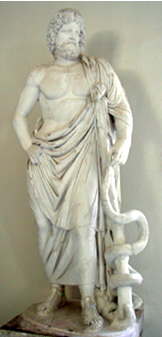
Without question, the ancient Greeks/Romans made use of Medical Cannabis. However as stated elsewhere, both the Greek and Roman peoples had the great misfortune of living in a geography without the more medically useful Cannabis Indica plant, and were forced to relay on the weaker Cannabis Sativa. But be that as it may, for whatever reasons, Greco-Roman medicine did not seem to take advantage of the medical properties of the flowering tops, only the seeds or in some cases the roots of the plant. And then only to treat, what can only be considered, very minor ailments.
But for good or for bad, (especially after the beginning of the dark ages) this limited use of Cannabis by Greco-Roman medicine would form the basis of the western medical knowledge for the next one and a half thousands years.
FOOTNOTES:
[1]- Unfortunately we were not able to obtain permission to use their pictures (great stuff) but they are all over the Internet, just look for the parka-Davies historical series.
[2]- Some spelling changed due to the awkward English made.
[2]- Translation from “De Alimentorum Facultatibus” (On the Properties of Foodstuffs) translation by Owen Powell
[3]- [While no one over here can read Latin, but we think this is the correct translation]
[4]- As mentioned in "Marijuana in Ancient Greece and Rome? The Literary Evidence", Bulletin of the History of Medicine, 47 (1973): 344-355 by T.F. Bruner -- making reference to; Fragment 13, Theodor Kock, Comicorum atticorum fragmenta (Leipzig: Teubner, 1884), vol. 2, pp. 256-257.
[5]- De Re Rustica 2.10.21., copies of the whole book are available for free downloads via the internet.
[6]- "Marijuana in Ancient Greece and Rome? The Literary Evidence", Bulletin of the History of Medicine, 47 (1973): 344-355 by T.F. Bruner
WANT TO KNOW MORE:
=====================
Due to space / download time considerations, only selected materials are displayed. If you would like to obtain more information, feel free to contact the museum. All our material is available (at cost) on CD-Rom format.
CONTACT PAGE
The Geoponica Back to the Last Section |
 BACK TO CHAPTER 2 |
GRECO-ROMAN On to the Next Section |